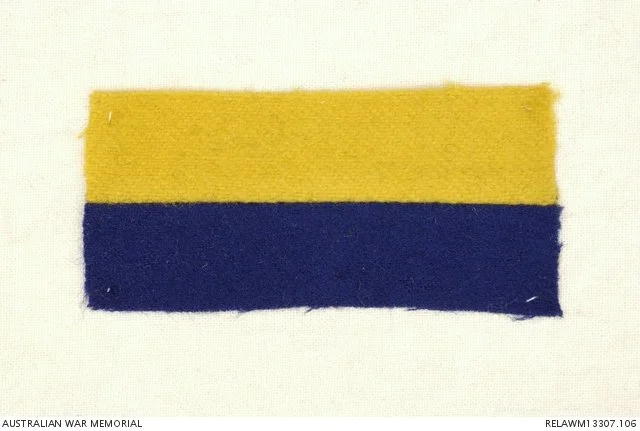The 14th Battalion was an infantry battalion of the Australian Army that served during World War One. It was raised in Queensland, Australia, in August 1914 as part of the Australian Imperial Force (AIF). The battalion formed part of the 4th Brigade, which was part of the 2nd Division.
1914. 14th Battalion marching down Alexandra Avenue, Melbourne to lunch at the Engineers' Depot after the march from Broadmeadows. Two dogs are to the right, possibly mascots and a mounted policeman is to the left. Note the men riding bicycles on both sides of the road.
The 14th Battalion embarked for overseas service in October 1914, arriving in Egypt where the Australian and New Zealand troops underwent training. In April 1915, the battalion took part in the landing at Gallipoli as part of the ANZAC (Australian and New Zealand Army Corps) forces. They were among the first Australian units to go ashore at what would become known as Anzac Cove.
During the Gallipoli campaign, the 14th Battalion fought in several significant battles, including the Battle of Lone Pine in August 1915, where they played a crucial role in the successful Australian assault on the Turkish trenches. The battalion remained at Gallipoli until December 1915 when the decision was made to evacuate the troops.
After the withdrawal from Gallipoli, the battalion returned to Egypt for reorganization and training. In March 1916, they were deployed to the Western Front in France and Belgium, where they saw heavy action throughout the war.
Studio portrait of Lance Corporal (L Cpl) (later Captain) Albert Jacka (later VC MC and bar) of the 14th Battalion. L Cpl Jacka was awarded the Victoria Cross for 'conspicuous bravery on the night of 19 and 20 May, 1915 at Courtney's Post, Gallipoli Peninsula.' He was holding a trench with four others, all of whom were killed or wounded, when it was attacked by seven Turkish soldiers. L Cpl Jacka defended the trench and killed all of the soldiers. He was the first Australian recipient of the Victoria Cross in the First World War. He later died of an illness on 17 January 1932.
The 14th Battalion took part in numerous major battles on the Western Front, including Pozieres, Bullecourt, Ypres, Passchendaele, and Villers-Bretonneux. They endured the harsh conditions of trench warfare, fought in costly assaults, and faced the devastating effects of modern warfare, including artillery barrages, machine gun fire, and poison gas attacks.
The battalion's most significant achievement during the war came during the Battle of Hamel on July 4, 1918. Under the command of Lieutenant General John Monash, the 14th Battalion and other Australian units played a pivotal role in a meticulously planned and executed assault that achieved all of its objectives within 93 minutes, demonstrating the effectiveness of combined arms tactics.
A Group from 9th Reinforcements, 14th Battalion. Egypt.
Throughout the war, the 14th Battalion suffered heavy casualties. Approximately 3,880 men served in the battalion, and of those, around 1,360 were killed, and over 2,000 were wounded. Their sacrifices and achievements in battles on the Western Front and Gallipoli are commemorated at numerous war memorials and cenotaphs in Australia.
The 14th Battalion was disbanded in early 1919 as part of the demobilization process following the end of the war. Its members returned to Australia, where they were welcomed by the grateful nation. The battalion's legacy lives on, and their contributions during World War One are remembered as a testament to the bravery and sacrifice of Australian soldiers during that time.
Melbourne, Vic. 1944-04-25. Servicemen and ex-servicemen behind the 14th Battalion banner give "eyes left" as they pass the Saluting Base in front of the Shrine of Remembrance during the Anzac Day March through city streets.





